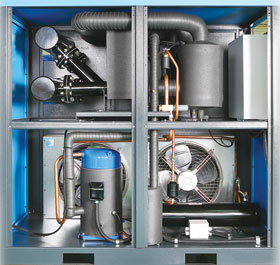

Compressed air dryers are designed to standard operating parameters. When a dryer is working with a given design volume within these conditions, compressed air at 3°C dew point and 7 barg will be achieved. The main components of a dryer – the freon compressor, the condenser and the heat exchangers – are thermally matched for a given air volume to achieve a set contact time for the compressed air and the cold freon gases. This ensures compressed air is cooled to 3°C at the smallest possible pressure drop. At 3°C, water condensate is removed to waste. Condensers must have sufficient surface area to dissipate the adsorbed heat generated in the freon circuit. If the heat load cannot be ejected, the freon pressure and temperature will rise and create a thermal overload, leading to a trip-out. Condensers are cooled by the ambient air temperature.
For the freon circuit to function continuously and reliably, the gas circuit’s cooling ability must exceed the work/heat load given by the air compressor and the prevailing atmospheric conditions. If the heat load from the compressor exceeds the cooling ability of the freon compressor circuit, then the air dryer will fail – either because the freon high pressure gas switch shuts the circuit down due to high heat /work load or because the freon compressor burns out due to high returning gas temperatures. If a trip-out is imminent, the dew point will be in the 10°C region or even higher. High dew points are not acceptable as poorly dried compressed air in the piping system allows water vapour to condense in the pipeline when airline temperatures drop during the night, or in the cooler months of the year.
For a large percentage of the year, South African ambient temperatures are higher than the design criteria of a dryer. These conditions can increase the heat load by up to 40%. To counteract this, the air flow volume, or heat load, needs to be reduced by a corresponding 40%. This reduction in work load allows the dryer’s freon circuit to gain control of the heat load again and to function continuously without mechanical trip-outs or failures. If the heat load is not reduced, the result will be constant air dryer mechanical failures and a lifetime of poor compressed air quality. This will lead to downtime and higher operating costs. The supplier’s sales brochure should provide a set of derate factors for the dryer volumes and give derate figures for higher temperatures for determining the real capacity of an air dryer under specific operating conditions.
Before laying money on the table do the homework, make enquiries, check the track record of the supply chain. How long has the supplier been selling this range, what aftercare is offered, can the selection be checked by using the factors in their literature. All these factors will help you make the correct choice of air dryer. Consider your purchase carefully before committing your hard earned capex budget.
For more information contact Allen Cockfield, Artic Driers International, +27 (0)11 420 0274, [email protected], www.articdriers.co.za
| Tel: | +27 11 420 0274 |
| Email: | [email protected] |
| www: | www.articdriers.co.za |
| Articles: | More information and articles about Artic Driers International |
© Technews Publishing (Pty) Ltd | All Rights Reserved